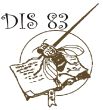
Drapeau, Mark D. 2000. Supplying food vials with paper. Dros. Inf. Serv. 83: 171.
|
|
|
|||
Supplying food vials with paper.
Drapeau, Mark D. Department of Ecology
and Evolutionary Biology, 321 Steinhaus Hall, University of California, Irvine,
CA 92697-2525. Phone: 949-824-5994,
Fax: 949-824-2181, Email: drapeau@darwin.bio.uci.edu
The presence of paper or
paper-like material (i.e., tissue) in vials and bottles filled with fly media is beneficial
for a number of reasons. These include absorbing extraneous water from the
top of the fly medium, the creation of "resting areas" for flies
that are not on the chewed-up medium, and the addition of surface area for
pupation. H.J. Muller published a paper in Drosophila Information Service
that proposed a "high-throughput" method for supplying vials with
paper (Muller, 1935). Briefly, Muller advocated purchasing pre-prepared white
paper confetti and sprinkling it en masse over a set of open-topped vials.
In this high-throughput new millennium, Muller's method may prove too slow
for some researchers. Indeed, the mere act of going to the store to purchase
confetti could slow progress down dramatically. Here, I propose an extension
of Muller's original method. Given that personal shredding machines are inexpensive
and abundant at universities, during normal administrative work periods a
scientist could increase productivity by utilizing the products of shredding
in the laboratory. Such products could be cross-shredded and then sprinkled
over open vials.
References: Muller, H.J., 1935, Dros. Inf. Serv. 3:
52.